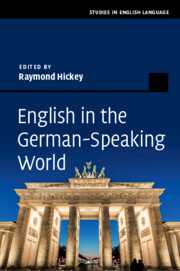Book contents
- English in the German-Speaking World
- Studies in English Language
- English in the German-Speaking World
- Copyright page
- Contents
- Figures
- Tables
- Contributors
- Preface
- Chapter 1 English in the German-Speaking World: The Nature and Scale of Language Influence
- I The Status of English
- II The Transmission of English
- III Domains and Features of English
- IV Beyond Germany
- Chapter 14 Varieties of English in the Netherlands and Germany
- Chapter 15 English in Austria: Policies and Practices
- Chapter 16 English in Switzerland
- Chapter 17 English and German in Namibia
- Chapter 18 English in German-Speaking Wisconsin and the Aftermath
- Chapter 19 The English ‘Infusion’ in Pennsylvania German
- Index
- References
Chapter 17 - English and German in Namibia
from IV - Beyond Germany
Published online by Cambridge University Press: 11 November 2019
- English in the German-Speaking World
- Studies in English Language
- English in the German-Speaking World
- Copyright page
- Contents
- Figures
- Tables
- Contributors
- Preface
- Chapter 1 English in the German-Speaking World: The Nature and Scale of Language Influence
- I The Status of English
- II The Transmission of English
- III Domains and Features of English
- IV Beyond Germany
- Chapter 14 Varieties of English in the Netherlands and Germany
- Chapter 15 English in Austria: Policies and Practices
- Chapter 16 English in Switzerland
- Chapter 17 English and German in Namibia
- Chapter 18 English in German-Speaking Wisconsin and the Aftermath
- Chapter 19 The English ‘Infusion’ in Pennsylvania German
- Index
- References
Summary
The global spread of English has resulted in ever-growing multilingual repertoires, various scenarios of language contact, variation, and change, and in the development of many (new) varieties of English. In this context, Namibia and the English language spoken here constitute a particularly interesting and unprecedented case. As the result of German colonial rule (1884–1915), South African occupation (1915/1921–1990), and the introduction of English as the sole official language with independence in 1990, three West Germanic languages are spoken alongside the local languages of the country, i.e. German, Afrikaans, and English. Of these, German functioned as official language from 1884 to 1915; from 1920 onwards, it was replaced by English and Cape Dutch/Afrikaans as the official languages, to which, however, German was added again as semi-official language in 1984 (Pütz 1992: 306). But with independence, and thus since 1990, English became the only official language of the country. The present use, function, and status of these three languages very much depend on these historical as well as on sociolinguistic factors such as region, age, ethnic group, education, or occupation.
- Type
- Chapter
- Information
- English in the German-Speaking World , pp. 334 - 360Publisher: Cambridge University PressPrint publication year: 2019



